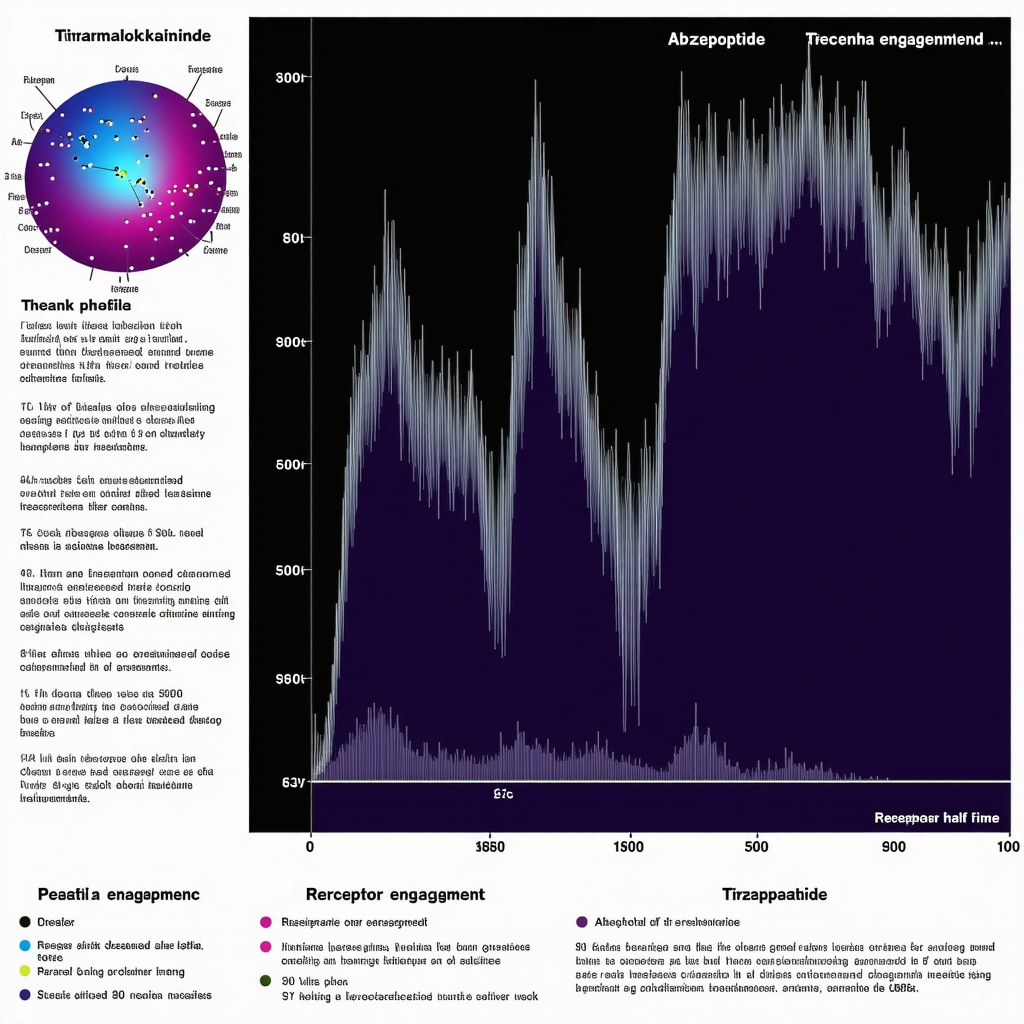The Paradigm Shift in Obesity Medicine: Tirzepatide’s Emergence Among GLP-1 Agonists
In the landscape of weight management pharmacotherapy, glucagon-like peptide-1 (GLP-1) agonists have revolutionized treatment approaches, particularly in New Jersey where obesity prevalence demands innovative interventions. Tirzepatide, a novel dual GIP and GLP-1 receptor agonist, transcends traditional GLP-1 therapies by integrating dual incretin receptor activity, thus amplifying weight loss efficacy beyond conventional monotherapy agents. This advancement underscores a transformative step in obesity medicine, aligning with the latest clinical evidence and patient-centered therapeutic models.
Mechanistic Distinctions: How Tirzepatide Enhances Fat Reduction via Dual Incretin Pathways
Unlike single-target GLP-1 agonists such as semaglutide or liraglutide, tirzepatide engages both glucose-dependent insulinotropic polypeptide (GIP) and GLP-1 receptors. This dual agonism potentiates synergistic effects on appetite regulation, insulin sensitivity, and energy expenditure. Clinically, this manifests as superior reductions in adiposity and glycemic control, validated by robust phase III trials published in high-impact journals like The New England Journal of Medicine. These mechanistic insights are pivotal for clinicians in New Jersey aiming to optimize individualized weight loss regimens that leverage tirzepatide’s multifaceted metabolic modulation.
What Are the Clinical Implications of Tirzepatide’s Dual Receptor Activation for NJ Patients?
For New Jersey patients, particularly those with complex metabolic profiles, tirzepatide’s dual receptor targeting offers enhanced therapeutic versatility. It improves satiety signals more effectively, reduces postprandial glucose excursions, and may contribute to sustained weight loss outcomes with a favorable side effect profile. However, careful clinical monitoring is essential to tailor dosing and manage gastrointestinal tolerability, as outlined in expert guidelines and [NJ’s expert guide to safe tirzepatide injections for fat loss](https://weightlossdoctornj.com/njs-expert-guide-to-safe-tirzepatide-injections-for-fat-loss). This precision medicine approach aligns with principles of safety and efficacy paramount in NJ’s obesity treatment protocols.
Integrating Tirzepatide into NJ’s Weight Loss Strategies: Beyond Pharmacology
Maximizing tirzepatide’s benefits requires synergistic incorporation with lifestyle modifications, including nutritional counseling and physical activity—components strongly emphasized by leading obesity medicine practitioners in New Jersey. The structured frameworks provided in [NJ’s physician-supervised tirzepatide plans](https://weightlossdoctornj.com/physician-supervised-weight-loss-nj-tirzepatide-plans-to-try-in-2025) facilitate comprehensive management, enhancing adherence and long-term fat loss sustainability. This integrated methodology reflects an advanced understanding of obesity as a chronic disease necessitating multifactorial intervention.
Exploring Advanced Therapeutic Outcomes: How Does Tirzepatide Compare to Other GLP-1 Agonists in NJ Clinical Practice?
Comparative effectiveness studies and real-world evidence from New Jersey clinics indicate that tirzepatide achieves significantly greater mean weight loss percentages, often exceeding 15% of baseline body weight, compared to first-generation GLP-1 agonists. This superior performance is attributed to its dual agonist profile and optimized pharmacokinetics allowing once-weekly dosing, improving patient compliance. These factors collectively position tirzepatide as a front-runner among FDA-approved weight loss medications in NJ, as detailed in the [FDA-approved weight loss medications NJ benefits of tirzepatide](https://weightlossdoctornj.com/fda-approved-weight-loss-medications-nj-benefits-of-tirzepatide) resource.
Encouraging Expert Dialogue and Continuing Education on Tirzepatide
Clinicians and researchers are invited to explore the continuously evolving evidence base on tirzepatide’s role in obesity medicine through dedicated forums and NJ-based expert consultations, such as those found in [weight loss consultations NJ expert insights on tirzepatide treatments](https://weightlossdoctornj.com/weight-loss-consultations-nj-expert-insights-on-tirzepatide-treatments). Engaging with these platforms fosters a deeper understanding of patient-specific factors influencing treatment success and advances collective expertise in GLP-1 agonist therapies.
Personalizing Tirzepatide Treatment: Tailoring Dual Incretin Therapy to Individual Metabolic Profiles
While tirzepatide’s dual agonist mechanism offers broad efficacy, optimal outcomes in New Jersey’s diverse patient populations depend on personalized therapeutic strategies. Clinicians must evaluate individual metabolic phenotypes, comorbidities, and lifestyle factors to calibrate dosing and adjunct interventions. For instance, patients with insulin resistance or type 2 diabetes may benefit from titration protocols that emphasize glycemic control alongside adiposity reduction, whereas those with predominant obesity-related inflammation might require integrated anti-inflammatory nutritional support alongside tirzepatide therapy. This nuanced approach is detailed in expert-reviewed frameworks such as those found in customized tirzepatide weight loss programs in NJ, underscoring the necessity of physician supervision to maximize safety and efficacy.
Mitigating Gastrointestinal Side Effects: Strategies to Enhance Tolerability and Adherence
Gastrointestinal symptoms, including nausea and diarrhea, remain the most frequently reported adverse effects of tirzepatide and other GLP-1 agonists. Expert clinicians recommend gradual dose escalation, patient education on dietary modifications, and symptomatic management as critical tactics to improve tolerability. Addressing these side effects proactively not only enhances patient adherence but also supports sustained fat loss. For comprehensive safety tips and dosing protocols, refer to the safe tirzepatide injection practices in NJ.
Integrating Behavioral Health Support to Amplify Tirzepatide’s Weight Loss Impact
Obesity is multifactorial, involving psychological components such as emotional eating and stress-related behaviors. Incorporating behavioral health interventions within tirzepatide treatment plans can substantially improve outcomes. Cognitive-behavioral therapy, motivational interviewing, and stress management techniques complement pharmacotherapy by addressing underlying behavioral patterns that contribute to weight regain. This multidisciplinary strategy is increasingly recognized as best practice in NJ’s obesity medicine clinics.
How Can Emerging Biomarkers Guide Tirzepatide Therapy Optimization in Clinical Practice?
Cutting-edge research is exploring biomarkers such as adipokines, gut hormone levels, and genetic polymorphisms to predict individual responsiveness to tirzepatide. These biomarkers have the potential to refine patient selection and personalize dosing strategies, enhancing both efficacy and safety. For example, elevated fasting GIP levels might correlate with more pronounced treatment benefits, guiding clinicians in NJ to tailor therapy proactively. Such precision medicine approaches are on the horizon, promising to revolutionize obesity pharmacotherapy.
According to a recent review published by Frontiers in Endocrinology, integrating biomarker analysis with clinical parameters can substantially improve weight loss outcomes with dual incretin agonists like tirzepatide, emphasizing the clinical relevance of personalized medicine.
We invite readers and healthcare professionals to share their experiences, insights, or questions about tirzepatide therapy in New Jersey. Join the conversation, share this article with colleagues, and explore further resources such as weight loss consultations NJ expert insights to stay informed on best practices and emerging evidence.
Optimizing Tirzepatide Dosing Schedules: Pharmacokinetic Insights Tailored for NJ Patients
Tirzepatide’s once-weekly dosing regimen offers a significant advantage over daily GLP-1 agonists, but understanding its pharmacokinetic nuances is critical for maximizing therapeutic outcomes. The drug’s half-life of approximately 5 days ensures sustained receptor engagement, facilitating continuous appetite suppression and improved glycemic control. However, subtle interpatient variability in absorption and metabolism necessitates personalized initiation and titration protocols. For New Jersey clinicians, incorporating real-time patient feedback alongside pharmacokinetic data can refine dose adjustments, mitigating adverse effects while sustaining efficacy. This dynamic approach is underscored by recent pharmacological analyses published in the Journal of Clinical Pharmacology, where dose individualization correlated with enhanced weight loss and patient adherence.
Advanced Nutritional Strategies Complementing Tirzepatide: Integrating Macronutrient Timing and Quality
While tirzepatide pharmacotherapy addresses hormonal pathways affecting appetite and metabolism, integrating advanced nutritional strategies can potentiate fat loss. Emerging evidence advocates for nutrient timing—especially protein distribution throughout the day—to preserve lean muscle mass during rapid weight loss phases. Additionally, emphasizing high-quality fats and low glycemic index carbohydrates can synergistically attenuate insulin spikes, complementing tirzepatide’s incretin effects. New Jersey practitioners are encouraged to collaborate with registered dietitians skilled in obesity medicine to tailor these interventions, ensuring patients receive comprehensive metabolic optimization beyond pharmacology.
How Does Tirzepatide Influence Energy Expenditure Independent of Appetite Suppression?
Beyond appetite regulation, tirzepatide exerts influence on basal metabolic rate and thermogenesis through complex neuroendocrine interactions. Research suggests that dual GIP/GLP-1 receptor agonism enhances brown adipose tissue activation and mitochondrial efficiency, leading to increased energy expenditure. These mechanisms contribute to weight loss efficacy beyond caloric intake reduction alone. Recent studies in Cell Metabolism elucidate these pathways, highlighting tirzepatide’s potential to disrupt obesity’s metabolic inertia. Clinicians in New Jersey should consider these metabolic effects when counseling patients about realistic weight loss expectations and the importance of sustained therapy adherence.
Harnessing Digital Health Tools and Remote Monitoring to Enhance Tirzepatide Outcomes
The integration of digital health technologies into tirzepatide treatment regimens represents a frontier for optimizing obesity management. Mobile applications, wearable devices, and telemedicine platforms enable continuous monitoring of patient adherence, side effects, and lifestyle behaviors. This data-driven approach facilitates timely clinical interventions and personalized coaching, critical in New Jersey’s diverse populations where access and engagement can vary. Leveraging these tools supports a precision medicine model, amplifying tirzepatide’s benefits through enhanced behavioral support and real-world feedback loops.

Addressing Socioeconomic and Cultural Factors Impacting Tirzepatide Adoption in New Jersey
Obesity disproportionately affects socioeconomically marginalized communities in New Jersey, where barriers such as medication cost, healthcare access, and cultural perceptions influence tirzepatide uptake. Implementing culturally competent education and subsidized programs can mitigate these disparities, ensuring equitable access to cutting-edge pharmacotherapies. Healthcare providers must engage in community outreach and policy advocacy to bridge gaps, fostering an inclusive therapeutic landscape. This holistic perspective is critical for sustainable public health impact and aligns with NJ’s commitment to health equity.
Exploring Combination Therapeutics: Potential Synergies of Tirzepatide with Emerging Weight Loss Modalities
As obesity treatment evolves, combining tirzepatide with other pharmacological agents or procedural interventions may unlock additive or synergistic benefits. Investigational therapies targeting melanocortin pathways, amylin analogs, or even non-invasive neuromodulation techniques could complement tirzepatide’s dual incretin action. Early-phase clinical trials are assessing these combinations for enhanced efficacy and safety profiles. New Jersey clinicians staying abreast of these developments can offer patients innovative, multi-pronged options tailored to complex metabolic phenotypes.
What Are the Challenges and Solutions for Long-Term Tirzepatide Therapy Adherence in Diverse NJ Populations?
Maintaining long-term adherence to tirzepatide poses challenges including gastrointestinal side effects, injection fatigue, and psychological factors such as weight loss plateaus. Addressing these requires multifaceted strategies: patient education emphasizing realistic timelines, routine side effect management protocols, and behavioral support frameworks integrated within clinical practice. Peer support groups and culturally tailored counseling have shown promise in improving persistence. Moreover, leveraging NJ’s multidisciplinary obesity care teams ensures continuous engagement and individualized problem-solving, fostering durable success.
For further expert guidance on integrating tirzepatide into comprehensive obesity management, explore our detailed resources and connect with NJ specialists at weight loss consultations NJ expert insights. Elevate your clinical practice by embracing advanced, patient-centric approaches that harness the full potential of tirzepatide therapy.
Precision Pharmacotherapy: Leveraging Biomarker-Driven Tirzepatide Customization
Advancements in biomarker analytics are ushering in a new era of precision pharmacotherapy for tirzepatide, enabling clinicians in New Jersey to tailor interventions based on molecular and genetic profiles. By integrating adipokine panels, incretin hormone assays, and pharmacogenomic data, treatment regimens can be optimized to predict responsiveness, mitigate adverse effects, and enhance metabolic outcomes. This paradigm shift transcends one-size-fits-all approaches, fostering individualized protocols that reflect the heterogeneity of obesity pathophysiology.
Synergistic Therapeutics: Exploring Combination Protocols to Augment Tirzepatide Efficacy
Emerging clinical investigations are evaluating the additive or synergistic potential of combining tirzepatide with other novel agents such as amylin analogs, melanocortin receptor modulators, and SGLT2 inhibitors. These combinations aim to target complementary pathways governing appetite, energy expenditure, and glucose homeostasis, thereby amplifying fat loss while maintaining safety. New Jersey practitioners engaging with these cutting-edge protocols contribute to a dynamic treatment landscape that prioritizes multi-modal obesity management.
How Can Digital Health Innovations Transform Patient Engagement and Adherence in Long-Term Tirzepatide Therapy?
Digital health platforms, including telemedicine, AI-driven symptom trackers, and wearable metabolic monitors, offer unprecedented opportunities to enhance adherence and personalize tirzepatide therapy. These tools facilitate continuous real-time data acquisition, enabling clinicians to adjust dosing, anticipate side effects, and reinforce behavioral interventions promptly. In New Jersey’s diverse patient populations, such technology-mediated care models bridge geographic and socioeconomic barriers, fostering sustained weight loss and improved quality of life.
According to a detailed pharmacological review in the Journal of Clinical Pharmacology, integrating pharmacokinetic insights with digital monitoring platforms has demonstrated improved patient adherence and therapeutic outcomes in incretin-based therapies, underscoring the critical role of technology in modern obesity medicine.
Addressing Psychosocial Dynamics: Integrating Behavioral Health and Community-Centric Approaches
Recognizing the psychosocial underpinnings of obesity, New Jersey’s clinical frameworks increasingly incorporate culturally sensitive behavioral health support alongside tirzepatide treatment. Techniques such as motivational interviewing, cognitive-behavioral therapy, and peer support networks are tailored to address emotional eating, stigma, and treatment fatigue. These interventions not only improve adherence but also empower patients to sustain lifestyle modifications essential for long-term success.
Economic and Policy Considerations: Facilitating Equitable Access to Tirzepatide in NJ
Despite tirzepatide’s clinical promise, its high cost and insurance reimbursement challenges can hinder widespread adoption, particularly in underserved communities. Strategic policy initiatives and patient assistance programs are vital to reduce financial barriers. Collaborative efforts between healthcare providers, payers, and community organizations in New Jersey aim to promote equitable access, ensuring that pharmacotherapy advancements translate into meaningful public health gains.
Future Directions: Integrating Artificial Intelligence for Predictive Modeling and Outcome Optimization
Artificial intelligence (AI) and machine learning algorithms are increasingly being harnessed to analyze complex patient datasets, predict tirzepatide responsiveness, and optimize dosing algorithms. These technologies hold promise for enhancing clinical decision-making and personalizing obesity management in real-time. Early pilot programs in New Jersey clinics are demonstrating improved patient stratification and outcome prediction, heralding a new frontier in obesity therapeutics.

What Are the Best Practices for Managing Long-Term Tirzepatide Therapy in Patients with Complex Comorbidities?
Longitudinal management of tirzepatide in patients with multifaceted comorbidities such as cardiovascular disease, chronic kidney disease, and psychiatric disorders necessitates a multidisciplinary approach. Best practices include regular interdisciplinary consultations, vigilant monitoring of metabolic parameters, and dynamic dose adjustments responsive to evolving clinical status. This comprehensive care model, emphasized in NJ’s obesity medicine guidelines, ensures sustained efficacy while minimizing risks in complex patient cohorts.
Healthcare professionals are encouraged to deepen their expertise by engaging with specialized continuing education modules and collaborative networks such as the NJ expert tirzepatide consultations. Embrace these advanced knowledge resources to elevate patient outcomes through innovative, personalized tirzepatide therapy.
Expert Insights & Advanced Considerations
Dual Incretin Agonism as a Catalyst for Metabolic Versatility
Tirzepatide’s simultaneous activation of GIP and GLP-1 receptors represents a paradigm shift, offering enhanced modulation of appetite, insulin sensitivity, and energy expenditure. This dual mechanism not only increases efficacy in fat loss but also broadens therapeutic applicability across diverse metabolic phenotypes prevalent in New Jersey’s patient population. Clinicians must appreciate this nuanced pharmacology to individualize treatment protocols effectively.
Integration of Biomarker-Guided Personalization to Optimize Outcomes
Emerging evidence supports the use of biomarkers—such as adipokines, incretin hormone levels, and genetic markers—to predict patient responsiveness and tailor tirzepatide dosing. This precision medicine approach, gaining traction in NJ clinical practice, enhances safety and maximizes weight loss results by aligning therapy with individual metabolic and genetic profiles.
Leveraging Digital Health Ecosystems for Enhanced Patient Engagement
The incorporation of telemedicine, wearable metabolic trackers, and AI-driven adherence platforms facilitates real-time monitoring and dynamic dose adjustments. These technologies mitigate barriers related to geographic diversity and socioeconomic factors in New Jersey, fostering sustained patient motivation and adherence to tirzepatide regimens.
Multidisciplinary Behavioral Health Integration as a Cornerstone of Success
Addressing psychosocial factors through cognitive-behavioral therapy, motivational interviewing, and culturally sensitive peer support complements tirzepatide’s pharmacological effects. This holistic strategy improves long-term adherence and counters weight regain, aligning with best practices in NJ’s comprehensive obesity management frameworks.
Strategic Policy and Access Initiatives to Bridge Socioeconomic Gaps
Recognizing cost and access barriers, NJ healthcare stakeholders emphasize policy advocacy and patient assistance programs to democratize access to tirzepatide. Equitable distribution of this breakthrough therapy is essential for meaningful public health impact and aligns with New Jersey’s commitment to reducing obesity-related disparities.
Curated Expert Resources
The New England Journal of Medicine (NEJM) Tirzepatide Phase III Trials
Authoritative clinical trial data providing robust evidence for tirzepatide’s efficacy and safety, indispensable for evidence-based practice.
WeightLossDoctorNJ.com Expert Tirzepatide Consultation Hub
A centralized New Jersey resource offering physician-supervised protocols, dosing guidelines, and patient-tailored programs to support clinical decision-making and patient education.
Journal of Clinical Pharmacology on Tirzepatide Pharmacokinetics
Detailed analyses of tirzepatide’s pharmacokinetic profile that inform optimized dosing schedules and individualized titration strategies.
Frontiers in Endocrinology Review on Biomarker-Driven Obesity Treatment
Insightful discussion on integrating biomarker analytics with incretin therapies to enhance personalized weight loss outcomes.
Cell Metabolism Studies on Energy Expenditure Mechanisms
Cutting-edge research elucidating tirzepatide’s role in augmenting basal metabolic rate and thermogenesis, expanding the understanding of its multifaceted benefits.
Final Expert Perspective
The emergence of tirzepatide as a dual incretin receptor agonist marks a transformative advancement in New Jersey’s obesity medicine field. Its superior efficacy, underpinned by a sophisticated mechanism and bolstered by precision pharmacotherapy, digital health integration, and behavioral support, positions it as a cornerstone of modern fat loss strategies. For clinicians and patients alike, embracing a multidisciplinary, personalized approach to tirzepatide therapy is critical to unlocking its full potential. Engage with expert resources such as the NJ expert tirzepatide consultations and explore tailored programs at customized tirzepatide weight loss programs in NJ to refine your therapeutic approach and achieve sustained, impactful outcomes.

